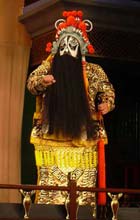
 Though Western music is popular among China's younger generation, traditional Chinese music can often be heard in parks and back street tea-houses. There, to the delight of an enthusiastic audience, aficionados gather to sing their favorite operatic arias. Of China's various operatic schools, the most famous is that which developed in her capital city, referred to simply as Beijing opera.
Though Western music is popular among China's younger generation, traditional Chinese music can often be heard in parks and back street tea-houses. There, to the delight of an enthusiastic audience, aficionados gather to sing their favorite operatic arias. Of China's various operatic schools, the most famous is that which developed in her capital city, referred to simply as Beijing opera.
This grew from the comedic and balladic traditions of the Northern Song dynasty (960-1127), its current form taking shape some two hundred years ago. Emperor Qianlong (r. 1736-1796) of the Qing dynasty, on a tour of southern China, is said to have developed a passion for opera. For his eightieth birthday therefore, he invited opera troupes from all over the country to perform in the capital. So impressed was he with the troupes from Anhui and Hubei provinces that he insisted they remain to develop what we nowadays refer to as Beijing opera. The synthesis of styles is still evident with the clown, female and child roles singing in Beijing dialect and the male and more serious adult roles singing in Hubei and Anhui dialects.
Beijing opera incorporates not only song and dance, but also acrobatics, martial arts, colorful make-up, and elaborate costumes. The singing is accompanied by string, wood and percussive instruments, consisting mainly of gongs, drums and clappers. The principal drummer, serving as the conductor, directs each scene's prevailing mood. Since the stage is usually bare, the audience's attention is directed to the actors' gestures, each of which is invested with meaning. Walking in a circle, for example, indicates a long journey. Two men somersaulting under a spotlight indicates a moonlit flight.
Unlike Western opera, where roles are categorized by voice, this is done in Beijing opera according to the characters' gender, age, social status, rank and disposition. Make up plays an essential role in distinguishing characters and their moral qualities. Whereas a red face indicates bravery, uprightness and loyalty, a yellow one indicates brutality and a white one cunning. The clown, is distinguished by a small patch of white chalk on or around the nose.
Stories are derived from novels, dramas and historical epics, and are usually divided into civil and military subjects. The civil dramas, whose main characters are usually women, deal with such social themes as love, family, marriage and relationships while military dramas, whose characters are dominated by men, investigate themes of power and warfare. Generally speaking, the Chinese do not like sad endings, which may be one of the reasons why tragedies have never been popular. Comedy is always present with at least one clown to provide relief in even the most serious of stories.